The 300 Patch is a tenth-acre plot of ground at the lower portion of our property. By 2005 we had collected 300 one gallon to five gallon cycads, most of which we had grown from seeds or purchased as seedlings as early as 1998. We had quickly learned that cycads in-the-ground grow 3 to 5 times faster than if grown in a container, and perhaps more important is that the cycad becomes acclimated—our customers never have to sneak cycads slowly out into the sun.
This plot was prepared by weeding, smoothing with a Bobcat tractor, then raking away surface rocks. A thick landscape fabric, termed soil cloth, was rolled and staked over this plot. Although I had a career in engineering and was trained to approach every task with planning and logic, I was surprised that planting cycads would be such an intensive thought process. Example, surely if plants love water, then weeds do, too. Weeding goes under the category of maintenance, and this can be overwhelming, similar to the (slightly modified) saying, “You go to drain the swamp but find yourself up to your rear-end in alligators”. This black soil cloth keeps out the sun so weeds do not grow, and also helps retain moisture in the ground by reducing evaporation. As well, this cloth serves to provide erosion control because without it heavy rains can wash away soil around a plant. {Vila}.
Next, a string with black marks 3 feet apart was stretched from left to right, then a template coffee can with razor knife was used to cut a circle away from this cloth at this mark. Another row was produced that was 4 feet away, and this continued until all 12 rows were completed. A manual post hole digger was used to make a hole at each of these spots allowing a cycad to be planted.
One-half inch poly drip tubing was anchored along each row, and connected to our irrigation system. At each plant location a 1/2 gallon drip irrigation emitter was placed. Irrigation was set for twice a week, for 2 hours each time. In the winter rains, the irrigation was turned off.
OK, these 5 year-old cycads began to grow in the ground starting October, 2005. That means these cycads have been growing for 20 years!
We all know that buying tiny cycads is like buying a “pig in a poke”. You have little knowledge how this cycad is going to look 20 years from now, and searching for photos on the Internet isn’t very informative. But with these 300 Patch cycads that are robust, mature, and essentially fully grown in the full arc of warm Escondido sun with micronutrients from the earth and a consistent regimen of water-soluble 20-20-20 fertilizer, you can see it, fully appreciate its appearance and envision how it would look in your garden.
Following this will be information for the remaining 3 cycad collections in this 300 Patch,
- Encephalartos natalensis
- Encephalartos trispinosus spineless
- Encephalartos aemulans
Here is a photo of the remaining 128 cycads in this 300 Patch on November 15, 2020. All of these cycads were tagged (keeping their ID is imperative), soil cloth was removed between the rows, and all cycads were tied up (easier to see when digging, and easier to put into containers). A Bobcat was used to dig 16” below the soil surface, then lift the cycad and place it on the ground elsewhere. This avoids the arduous task of hand-digging each cycad with a shovel. Once the cycad is moved, one uses a citrus shovel to cut a circle 8” away from the caudex and 16” deep, then this cycad is lifted up and out. This cycad then has a wrap of soil with little root damage and can be placed into a 15 gallon or 20 gallon container of our quality soil mix with lava rock.
128 Cycads remaining in the 300 Patch on November 15, 2020

---------------------------------------------------------------------------------------------------------------------------------------------------
The following photos are of the remaining E. natalensis dug January 6, 2021. They are about 20 years old. Cycad references state the stem (caudex) can become 15.75”, thus the two cycads having 13.5” to 14” caudexes are nearing their terminal size. These habitat measurements state a terminal plant height of about 20 feet but habitat maximum height predictions are rarely achieved by cycads grown in CA; a more likely terminal height would be 12 feet in say, another 20 years. The leaves are of medium size, 5’ to 10’ long, dark green with few prickles/barbs on the margins of the leaflets. The 20” to 24” length cones are spectacular. {PZA}
This cycad is cold hardy and will thrive in southern CA.
E. natalensis collection, these remaining 13 cycads have been dug and are shown in containers.
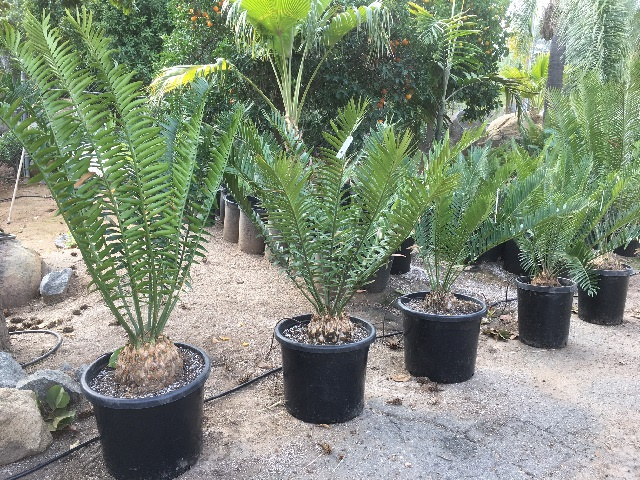
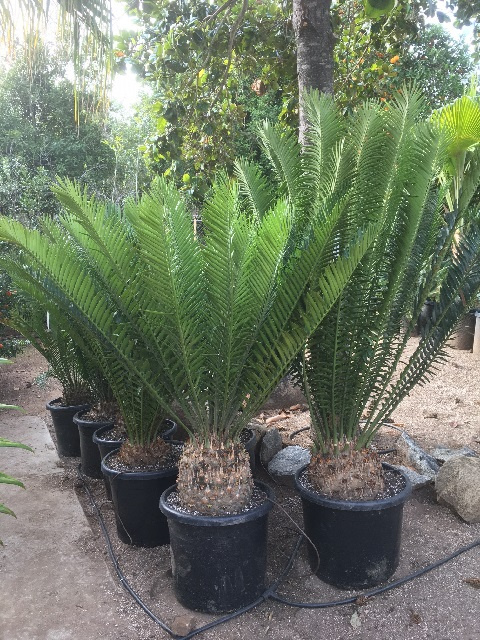
Newly available E. natalensis cycads,
| Encephalartos natalensis |
|
$79 |
|
15 gal, 6.5"
|
1
|
|
|
15 gal, 7.5"
|
1
|
|
|
20 gal, 10"
|
1
|
|
|
20 gal, 10"
|
2
|
|
|
20 gal, 10" (m)
|
1
|
|
|
20 gal, 10.5"
|
1
|
|
|
20 gal, 11"
|
2
|
|
|
20 gal, 12"
|
1
|
|
|
20 gal, 8.5", 4" (12.5")
|
1
|
|
|
20 gal, very large, 14" cw, 13" ch
|
1
|
|
|
|
|
----------------------------------------------------------------------------------------------------------------------------------------------
The following photos are of the remaining E. tri-spineless dug January 7, 2021. They were purchased as liners (seedlings) March 29, 2003, and are about 19 years old. This cycad was made possible by crossing a true male tri-spineless (available only by pollen from Africa) with a female tri (why not a female tri-spineless? the true female spineless was not available, maybe it no longer exists). This produced a cycad that isn’t perfectly spineless but is quite close. From our observations, the straight trispinosus and the tri-spineless differ only in prickles/barbs along the leaflet margin; the tri-spineless margins are relatively smooth and reminiscent of the E. lehmannii, with color not bright blue but gray-green to darker blue.
Cycad references state that the stem (caudex) can become 10” to 12” {Wiki}, while these cycads have caudexes ranging from 4.5” to 7.5”, roughly half their terminal growth—recall that the previous green cycads of the same age had caudexes close to terminal growth. Put your thinking cap on—Why is the terminal size of the tri-spineless caudex half the terminal size of the green cycad? You know that answer: blue cycads grow much slower than green cycads. Another observation: There is a large variation in the height of these tri-spineless cycads. Why? Since these are naturally smaller cycads, many became shaded by nearby larger cycads, so shade can slow growth as well. Cycad references state that the tri-spineless terminal height is 1 meter or 33 inches {Wiki}. Most of these plant heights range from 20 inches to 30 inches so it is unlikely they will grow much taller.
This cycad is cold hardy and will thrive in southern CA.
E. trispinosus spineless collection, 16 cycads are available in containers.
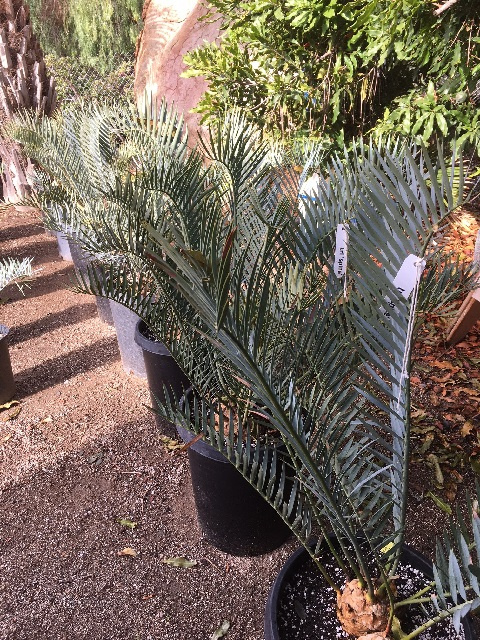
E. trispinosus spineless, 9” with attractive male cone, dug December 20, 2020. Note that most leaflets have perfectly smooth margins. A specimen.
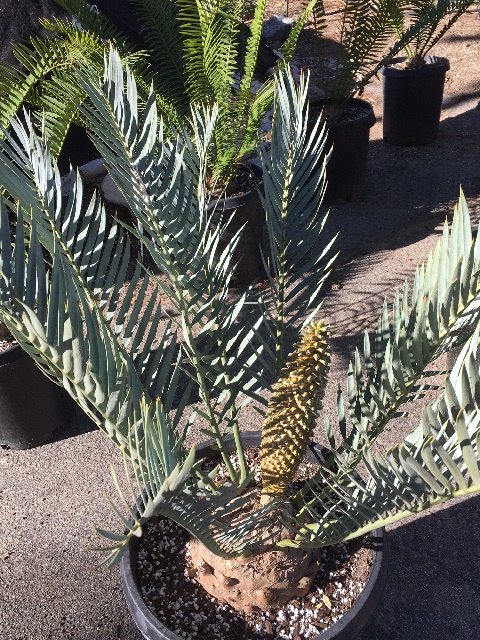
Newly available E. trispinosus spineless cycads,
| Encephalartos trispinosus spineless |
|
$149 |
|
5 gal, 4.5"
|
1
|
|
|
15 gal, 4.5"
|
1
|
|
|
15 gal, 5"
|
3
|
|
|
15 gal, 5"
|
1
|
|
|
15 gal, 5.5"
|
2
|
|
|
15 gal, 6" 1 was SOLD!
|
1
|
|
|
15 gal, 6", 1" (7")
|
1
|
|
|
15 gal, 7.5" SOLD!
|
0
|
|
|
15 gal, 7.5" SOLD!
|
0
|
|
|
15 gal, 4.5", 4" (8.5")
|
1
|
|
|
20 gal, 4.5" very large root base, will zoom!
|
1
|
|
|
20 gal, 7.5"
|
1
|
|
|
|
|
|
|
|
-----------------------------------------------------------------------------------------------------------------------------------------------
The following photos are of the remaining E. aemulans dug January 21, 2021. They were purchased as liners (seedlings) March 29, 2003, and are about 19 years old.
Cycad references state that the stem (caudex) can become 14” {Wiki}, while these 19 year-old cycads have caudexes ranging from 5” to 13”. Cycad references state that the plant terminal height is 10 feet {Wiki} while these cycads are about 4 feet tall. The reason for the wide variation in caudex width and plant height isn’t understood but every one of these cycads is robust and healthy, with no brown leaves. Adjacent plants within a row in the ground were quite different yet the irrigation and exposure to sun was nearly identical.
This cycad is cold hardy and will thrive in southern CA.
E. aemulans collection, the remaining 20 cycads have been dug and have been placed in containers. Note the 2nd column 13” E. aemulans with huge female cone.
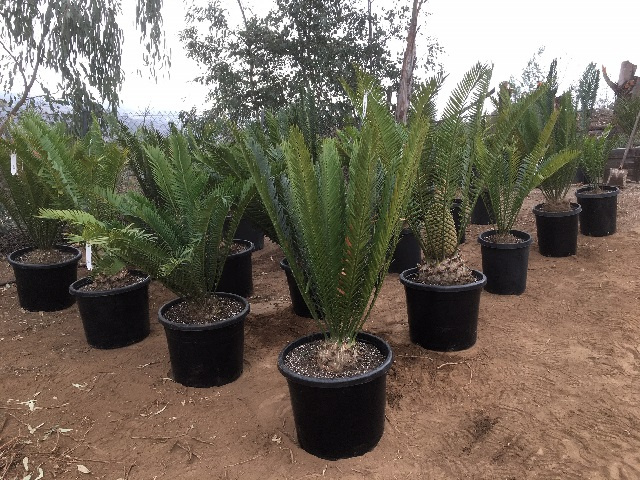
E. aemulans, 20 gallon, 10”. This E. aemulans wants to stand out—it is a large and an extremely gnarly cycad. A specimen!
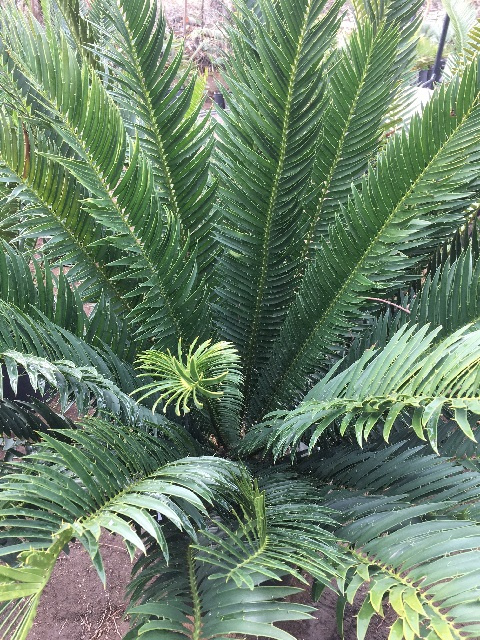
Newly available E. aemulans cycads,
| Encephalartos aemulans |
|
$119 |
|
5 gal, 2"
|
1
|
|
|
7 gal, 3"
|
1
|
|
|
15 gal, 4"
|
1
|
|
|
15 gal, 5"
|
1
|
|
|
15 gal, 5"
|
1
|
|
|
15 gal, 5.5"
|
1
|
|
|
15 gal, 6"
|
1
|
|
|
15 gal, 7"
|
1
|
|
|
15 gal, 7" + 1 pup
|
1
|
|
|
15 gal, 7.5"
|
1
|
|
|
15 gal, 8"
|
1
|
|
|
15 gal, 8"
|
1
|
|
|
15 gal, 9"
|
1
|
|
|
15 gal, 11"
|
1
|
|
|
15 gal, 12"
|
1
|
|
|
20 gal, 8"
|
1
|
|
|
20 gal, 8.5"
|
2
|
|
|
20 gal, 9"
|
2
|
|
|
20 gal, 9" (f)
|
1
|
|
|
20 gal, 9.5"
|
1
|
|
|
20 gal, 10", large. long caudex
|
2
|
|
|
20 gal, (10.5") 7.5", 3", long caudex
|
1
|
|
|
20 gal, 12", long caudex
|
1
|
|
|
20 gal, 12", long caudex
|
1
|
|
|
24" box, 16" specimen!
|
1
|
|
|
|
|